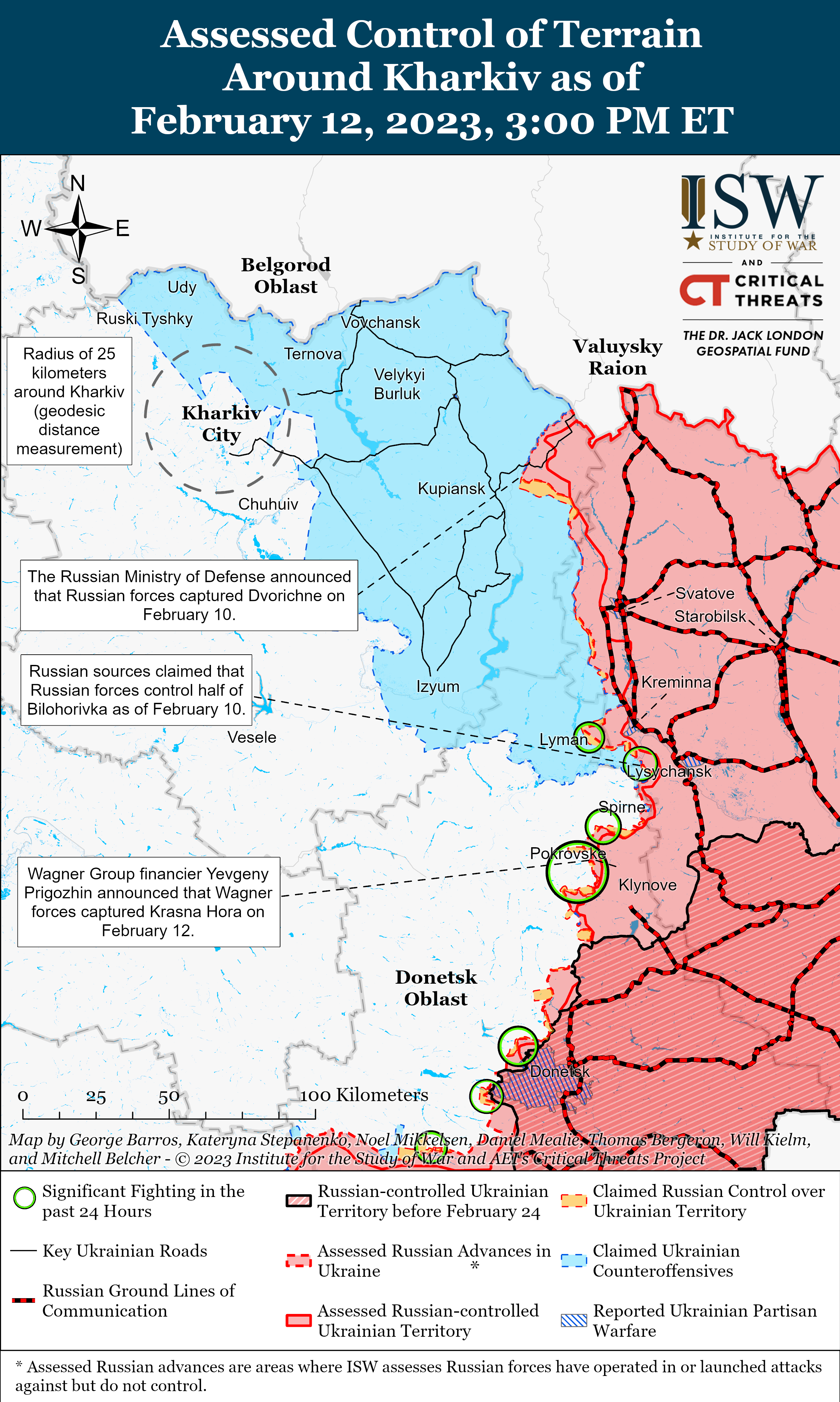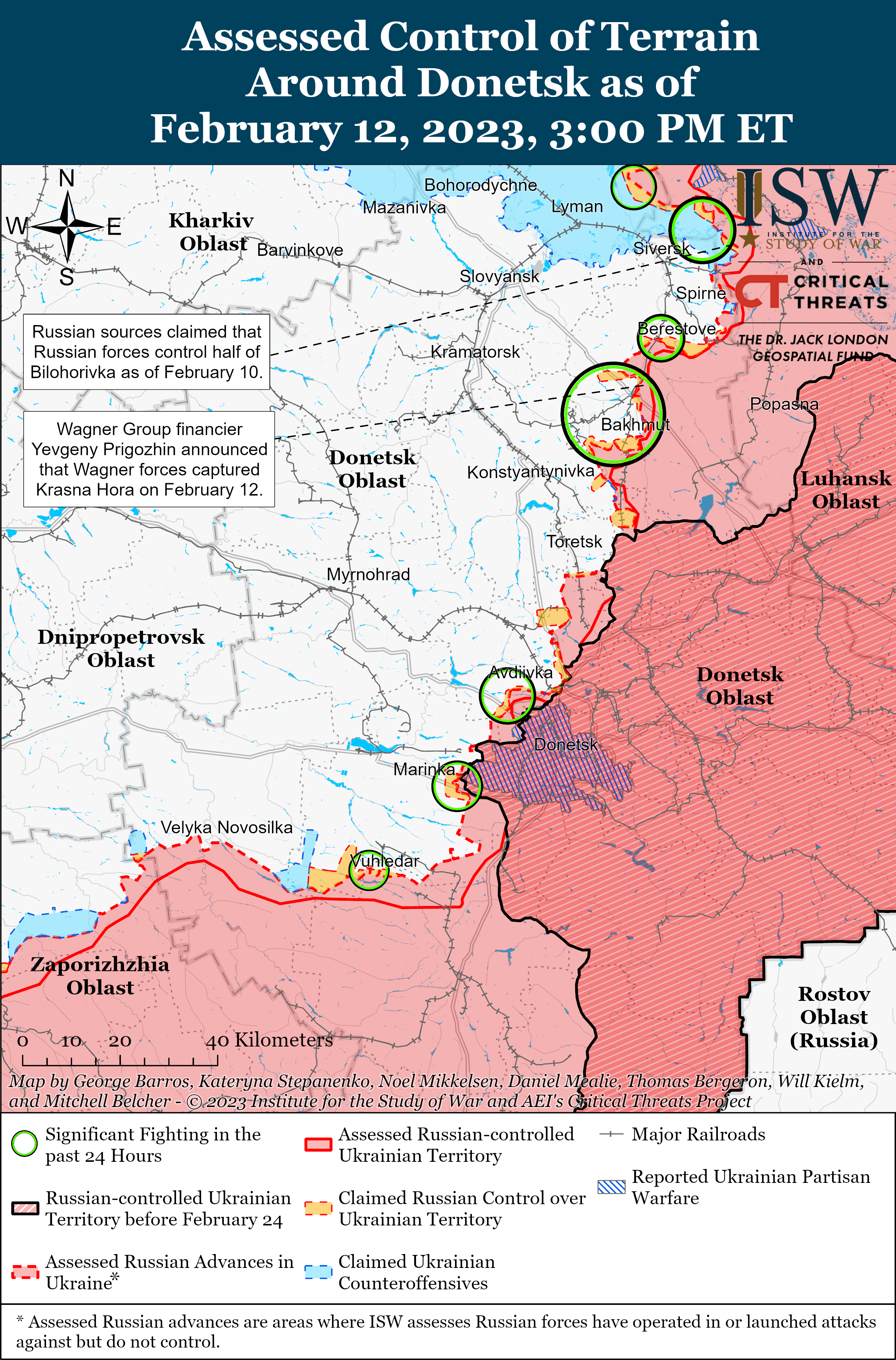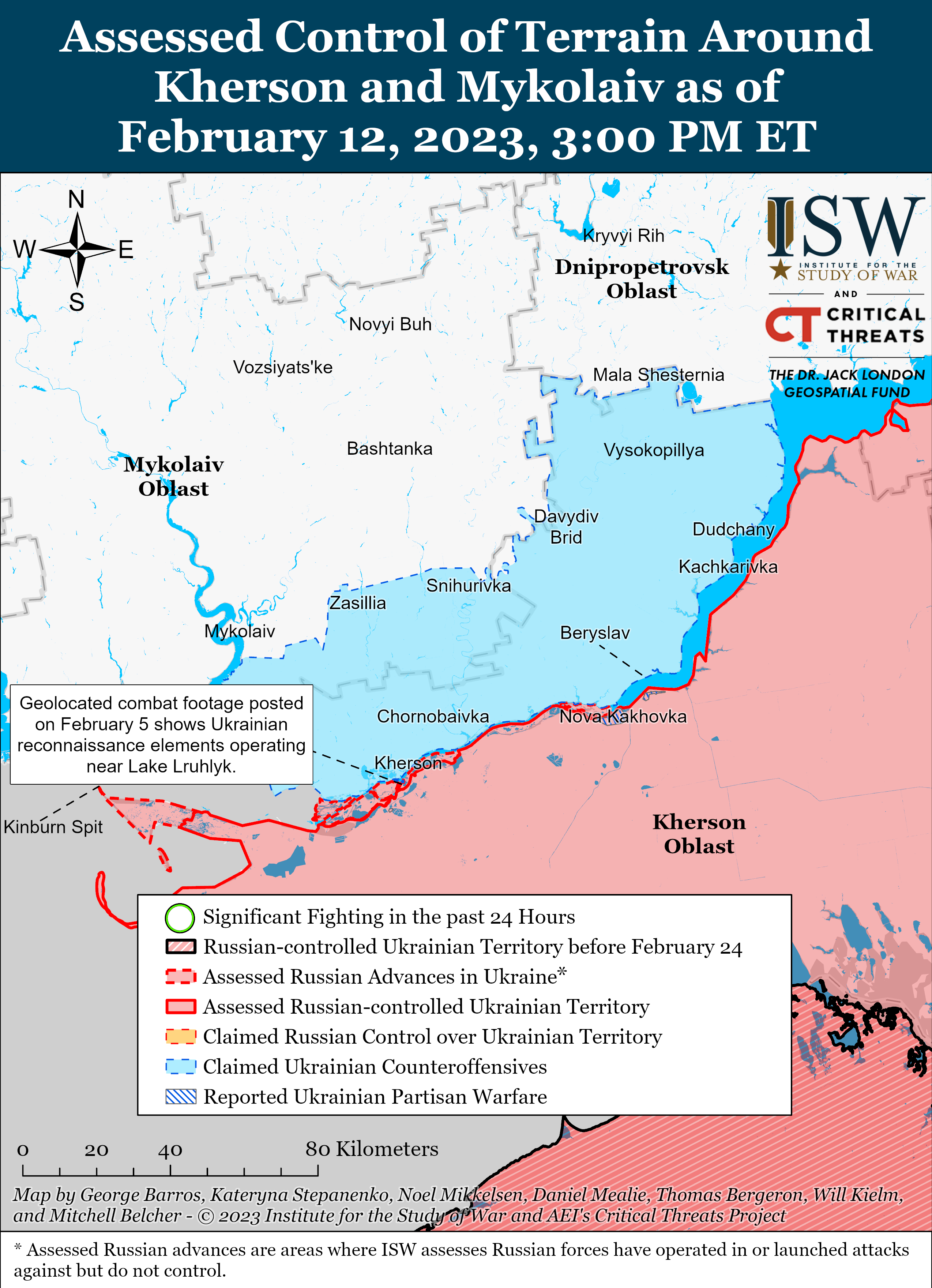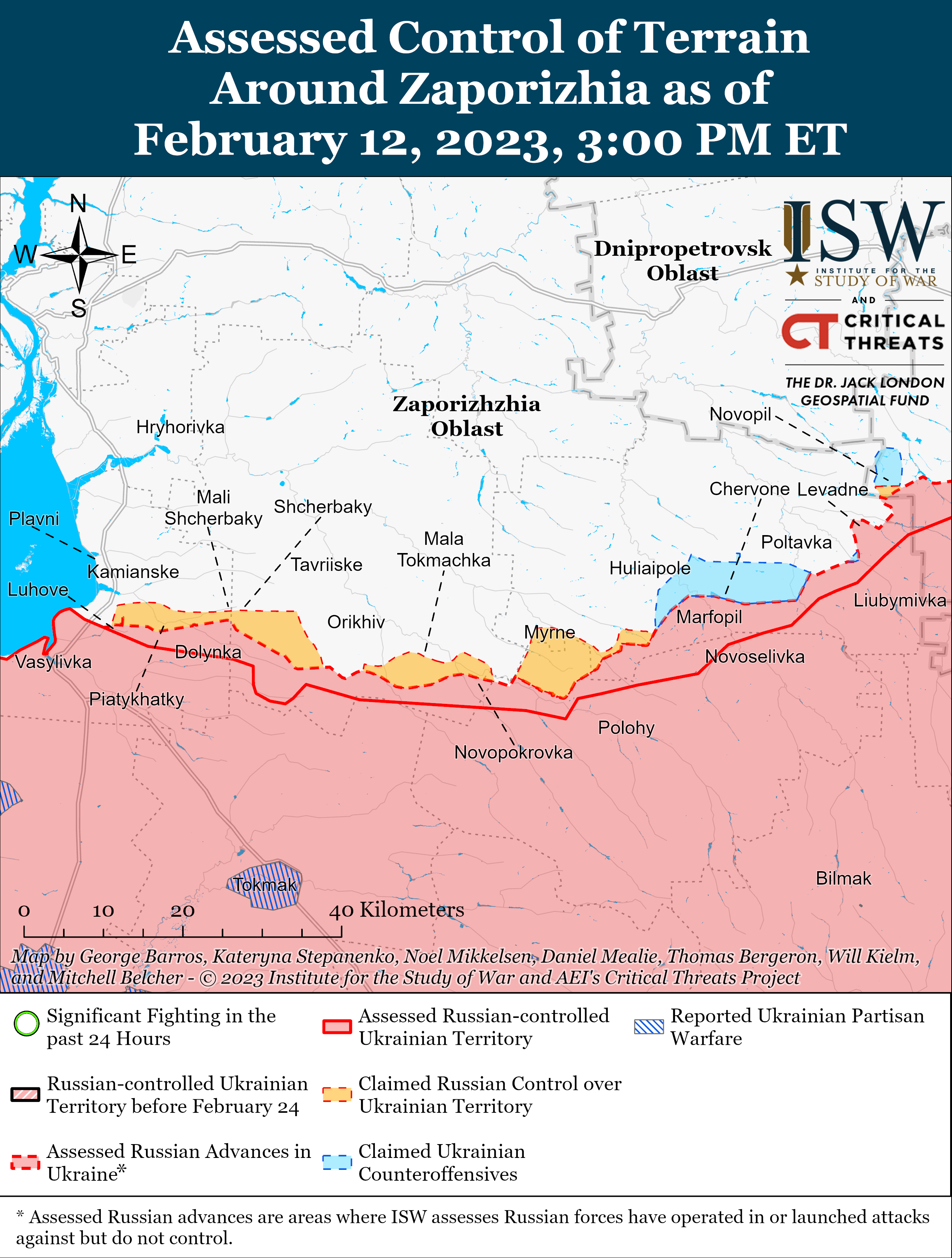Kateryna Stepanenko and Frederick W. Kagan
February 12, 8:45 pm ET
Click here to see ISW’s interactive map of the Russian invasion of Ukraine. This map is updated daily alongside the static maps present in this report.
ISW is publishing an abbreviated campaign update today, February 12. This report focuses on the impact of Russian information operations on delaying and deterring Western transfers of high-end weapons systems and other military aid to Ukraine. Russia has partially reconstituted its ability to conduct information operations as part of its hybrid warfare campaigns in support of military operations. These information operations will continue to emerge as Russia attempts to set conditions for upcoming operations and mitigate setbacks, and the West must critically evaluate the context of Russian information operations and avoid simply interacting with them on their own terms.
Russia has partially regained the ability to conduct successful information campaigns in support of strategic objectives and even discrete operational aims. Russian hybrid warfare theory has long called for the integration of information campaigns and military operations, with information operations sometimes taking precedence over kinetic activity.[1] Russia skillfully conducted multiple information campaigns over the two decades preceding the re-invasion of Ukraine in February 2022, most notably those that supported the Minsk II Accords in which Germany and France accepted Russia as a mediator rather than a belligerent in Ukraine.[2] The Biden Administration conducted a remarkable and successful counter-information campaign in the months leading up to the February 2022 full-scale invasion, however, disrupting multiple Russian information campaigns intended to induce Ukrainian surrender, separate Ukraine from the West, and create favorable conditions for the re-invasion.[3] The Biden Administration and the West have also cut off and derailed Kremlin-controlled media operations in the United States and Europe since the start of the re-invasion, causing the Kremlin to struggle to conduct successful information operations.[4] Moscow, as a result, has been unable to achieve the objectives that its pre-re-invasion campaigns had been pursuing. Russia has, however, reconstituted the ability to conduct discrete information campaigns in support of specific strategic objectives and to tailor those campaigns to mitigate battlefield setbacks and to set conditions for future planned operations.
Russian information campaigns have supported a continuous strategic objective of deterring or slowing the West’s provision of material support to Ukraine. Russian President Vladimir Putin likely bought into his own pre-invasion narrative that the West would not support Ukraine but would instead seek to maintain good relations with Russia, fueling his hopes for a speedy victory in Ukraine.[5] Putin soon realized that the war would protract due to his military’s inability to achieve decisive victories and Ukraine’s surprising (to him) determination to resist, and because of the West’s surprising (to him) willingness to support Ukraine’s resistance.[6] Putin thereupon began to focus on feeding the arguments Western leaders were making to themselves about the dangers of providing Ukraine with too much materiel or certain kinds of materiel.[7] These Russian information campaigns have been continuous in their pursuit of the common aim of inhibiting Western support for Ukraine regardless of battlefield conditions. The operational-level information campaigns discussed below nest into this strategic purpose, suitably adjusted for the specific battlefield circumstances of the moment.
Russia’s operational-level information campaigns aim either to set conditions for planned Russian operations or to mitigate Russian military failures. Russia shapes the information space in preparation for offensive operations to impede Ukraine’s ability to retain the battlefield initiative or prepare for the offensives. Russia also uses information campaigns to deter the West from supporting Ukraine’s counteroffensive efforts and exploitation of Russian military setbacks. Some of these Russian information campaigns are also intended to reestablish Russia’s geostrategic deterrence by rebuilding the projection of power that had been the focus and hallmark of Russian information campaigns before the 2022 re-invasion.[8]
Russia uses the narrative that Ukraine is incapable of defeating Russia because of inherent power disparities between the two states to mitigate major Russian setbacks or Russian failures to achieve rapid successes in major offensive operations. Russian information campaigns earlier in the invasion relied on amplifying the assumption that Russia possesses the “second largest military in the world” with advanced military capabilities. These information operations aimed to mislead the West and Ukraine into believing that any transfers of military equipment would be irrelevant because Ukraine would not be able to withstand rapidly unfolding offensive operations from different directions and would be vulnerable to Russian attack. The Kremlin, for example, threatened that Russia would view continuing Western military aid shipments to Ukraine as legitimate military targets in early March 2022.[9] The Russians have not shown the dynamic targeting capabilities needed to strike Western materiel moving into and through Ukraine throughout the first year of the war, however, and have instead resorted to wasting their precision weapons on striking fixed civilian energy infrastructure throughout Ukraine.
The Kremlin reframed its information operations to exaggerate the importance of every tactical advance following the Russian withdrawal from Kyiv Oblast and redeployment to Donbas in spring-summer 2022. The narrative adjusted the idea of Russian military might from sweeping offensive operations that were no longer possible to make much of steady and grinding gains on the frontlines.[10] This narrative aimed to demoralize Ukrainians and convince the West of Ukraine’s inability to stand against the supposedly overwhelming force enabling Russia’s costly advances, which ultimately culminated throughout the theater without achieving decisive strategic effects.[11] The exaggerating of minor victories also allowed the Kremlin to explain away the slow pace of offensives to domestic audiences who were conditioned to expect Russia’s rapid success in Ukraine.[12] Both versions of the narrative—the anticipated blitzkrieg at the start of the war and the impression of an unstoppable, if slow, advance during its second phase—were intended in part to deter Western aid provision. They sought to reinforce pre-invasion perceptions of Russian power and to trivialize Ukraine’s successful resistance in hopes that the West would give up on supporting Ukraine’s efforts to win the war. In this, they failed.
Russia intensified narratives about the risk of nuclear escalation in September-November 2022 to reestablish deterrence and dissuade the West from providing Ukraine the materiel needed to continue its counteroffensives following devastating Russian military failures in Kharkiv Oblast. Putin began making deliberately vague and general references to nuclear use during his annexation speech on September 30 following sweeping Ukrainian counteroffensive operations in Kharkiv Oblast.[13] The spike in nuclear rhetoric also followed Putin’s unpopular September 21 mobilization order, which had made Putin vulnerable within both the international and the domestic spheres.[14] Putin and key Kremlin officials intensified nuclear escalation rhetoric throughout October 2022, eventually culminating in early to mid-November likely as a result of growing international dialogue with Russia and pushback against his nuclear threats.[15] Putin has often used thinly-veiled nuclear threats to project the idea that Russia is a great power with which the West should avoid confrontation.[16] The nuclear information operation in fall 2022, however, was likely specifically intended to deter the West from immediately reinforcing Ukraine’s sweeping counteroffensives in eastern and southern Ukraine by stoking irrational and unjustified fears that Putin might react to a Ukrainian victory with nuclear escalation. Putin remains a highly calculating and risk-averse actor who will continue to exploit Russia’s nuclear capabilities and Western fear of nuclear escalation to project his power in the West and Russia without actually risking a nuclear exchange with NATO.[17] Putin also likely sought with these information operations to reestablish Russia’s standing as a great power in the world and to save face domestically following humiliating military setbacks.
It is now clear that the Russian information campaign centering on peace negotiations that intensified in December 2022 was aimed—among other things—at delaying the provision of Western tanks and other advanced equipment essential for the continuation of Ukrainian mechanized counteroffensives in order to set conditions for Russia’s own planned offensives. The Kremlin sharply amplified a false negotiations narrative throughout December 2022, with numerous Russian officials giving intentionally misleading signals of Moscow’s willingness to engage in serious negotiations with Ukraine.[18] The Kremlin originally introduced this information operation in early September 2022 after Ukraine announced the start of counteroffensive operations (ostensibly in Kherson Oblast) but prior to Ukraine’s liberation of much of Kharkiv Oblast, and Putin mentioned the idea of a return to the negotiation table in his September 30 annexation speech.[19] The Kremlin, however, consistently retained its maximalist goals and did not offer any serious bases for negotiations. The intensification of the narrative in winter 2022 coincided with Russian preparations for a major offensive operation planned for early 2023, and the Kremlin sought to capitalize on the Western desire for peace negotiations and thereby discourage the provision of Western tanks to Ukraine before Russia was able to regain the initiative in eastern Ukraine.[20] Russian Foreign Minister Sergey Lavrov notably signaled the end of the information operation, for the time, by announcing that Russia would continue to pursue a military solution in Ukraine on December 27.[21] It was too late, by that point, for the West to send tanks in time to interfere with the Russian offensive operation that began roughly a month later. The Russian peace-talks narrative was not, to be sure, the only or even the main reason for the delay in the Western provision of tanks to Ukraine. The timing of its onset, intensification, and dropping by the Kremlin, however, strongly suggests that it was timed to support the now ongoing Russian offensive.
Russia continues its shaping effort targeting Western provisions of long-range weapons and tanks to Ukraine by spreading the narrative that Ukraine will deliberately threaten Russia with these weapons instead of prioritizing the liberation of its Russian-occupied territories. Putin accused the United States of purposely protracting the war on December 22, 2022, following the US authorization to transfer Patriot air-defense systems to Ukraine on December 21, 2022.[22] Putin absurdly implied that Ukraine would use Patriots (defensive air-defense systems) to strike Russian territory, even as Ukraine begged for these systems to stop Russia’s ongoing air and missile campaign on Ukrainian energy infrastructure in the fall of 2022. This information operation was intended, like the negotiations information campaign, to stall Western aid that would disrupt ongoing and planned Russian military operations.
Kremlin officials are continuing to foster the narrative that Western transfers of longer-range precision rocket systems and Leopard tanks pose some new threat to Russian security, even though they pose no greater threat than the provision of Soviet tanks or other precision systems.[23] Ukrainians have not used Western-provided HIMARS systems to strike Russian territory even though those systems already brought important locations within Russia into range. And the idea that Ukraine will mount an invasion of Russia with Germany‘s Leopards is laughable. The purpose of this Russian information campaign is two-fold: first, to delay the arrival of Western tanks for as long as possible in order to delay the resumption of Ukrainian counter-offensives and buy time for Russia’s own offensive operations, and second, to disrupt the formulation of a coherent Western approach to shifting Ukraine fully to Western weapons systems—something the West will have to do eventually as it has run through its stocks of Soviet-era weapons and cannot produce or acquire more of them.
Russia will continue to weaponize information operations to directly support discrete military operations in Ukraine—especially after it has regained the initiative on the frontlines in eastern Ukraine. The Kremlin is resuming a narrative exaggerating Russian frontline victories with the ongoing offensives on Bakhmut and Lyman. The Russian Ministry of Defense (MoD) is proudly parading victories over captured settlements around Bakhmut, but the impact of such information operations is waning—both Ukraine and pro-war Russian nationalists have become less willing to accept claims of inevitable Russian victory at face value because of the year of Russian military incompetence.[24] But these information operations can nevertheless regain traction if Russian forces begin to make significant gains, and Russian information operations that appear to be ineffective now can nevertheless set conditions to become much more potent when circumstances change.
The Kremlin appears to be developing other narratives at the time of this publication as well, with nationalist officials making outlandish nuclear threats as a response to recent Western weapons provisions and transfer pledges.[25] Russian Deputy Foreign Minister Sergey Vershinin also started to resume the canard of Russia’s willingness to negotiate with Ukraine “without preconditions” on February 11 but “on the basis of the reality that exists today” and with consideration for Russia’s maximalist objectives—conditions, in other words, that still amount to Ukrainian surrender.[26] The Kremlin may also reintroduce the stalemate narrative that it had previously used to discount Ukrainian counteroffensives in Kherson in late August 2022.[27] Vershinin’s statement may be an evolved peace-talks narrative that seeks to pressure the West to force preemptive concessions on Ukraine or preempt the culmination of the Russian operations in Donbas. It may also be a continuation of Russian efforts to delay and disrupt the provision of weapons systems Ukraine needs to take advantage of that culmination. The West should consider that Russian discussions of negotiations may not be about negotiations or conditions for peace at all, but may rather be information campaigns specifically targeted at getting Russia through windows of opportunity or vulnerability on the battlefield.
All these information campaigns will support overarching Kremlin strategic aims of splitting the West from Ukraine, deterring or delaying the provision of Western materiel, and generally undermining Western support for Ukraine and the cohesion of the Western coalition. Many information campaigns will also pursue specific operational objectives setting conditions for planned Russian military undertakings. Western leaders must recognize these operations for what they are within the context of battlefield events and resist the temptation to engage with Russian information operations purely on their own terms. More of these narratives will emerge, and the West must critically consider battlefield realities to undermine the effectiveness of the Russian hybrid-warfare efforts. The West must monitor the emergence and intensification of certain information operations at particular times to properly assess and react to these campaigns, just as the Biden Administration did before the full-scale invasion in February 2022. Russia’s ability to conduct skillful information campaigns in support of hybrid warfare efforts was severely damaged by the Biden Administration’s skillful counter-information campaign and by Russia’s own actions and failures in Ukraine. But Putin is working to restore his capabilities in this area and is achieving limited but important successes, especially when he can shape information campaigns that resonate with discussions and fears that are already salient in the West.
Key inflections in ongoing military operations on February 12:
- Ukrainian officials continued to question the Russian military’s ability to launch large-scale strategic offensive operations in Ukraine.[28]
- The UK Ministry of Defense (MoD) reported that Russian forces have likely suffered the highest rate of casualties in Ukraine since the first weeks of the invasion based on statistics obtained from the Ukrainian General Staff, with an average of 824 casualties per day in the past week.[29] The UK MoD stated that they cannot verify the Ukrainian General Staff’s methodology for counting Russian casualties.
- A Russian State Duma parliamentarian called for increased censorship legislation to protect Russian military figures from criticism.[30]
- The Ukrainian Main Military Intelligence Directorate (GUR) released an intercepted call excerpt of Shahed drone operators in Ukraine speaking in Kurdish and Farsi and stated that Russian forces may be using Kurdish mercenaries to operate Iranian drones in Ukraine.[31]
- Russian sources claimed that Russian forces are continuing offensive operations northwest of Svatove.[32] Russian forces continued offensive operations around Kreminna with a reported 23 combat clashes in the area.[33]
- Russian forces continued ground attacks around Bakhmut, Avdiivka, and Vuhledar.[34]
- Wagner Group financier Yevgeny Prigozhin claimed that Wagner Group forces seized Krasna Hora north of Bakhmut.[35] Prigozhin also falsely claimed that Wagner Group forces are the only Russian forces within a 50km radius of Bakhmut.[36]
- Ukrainian officials reported that Russian forces in Kherson Oblast lack the capability to start a full-scale offensive, supporting ISW’s prior assessments.[37]
- Ukrainian Main Military Intelligence Directorate (GUR) representative Vadym Skibitsky stated that Ukrainian officials believe that Russian officials will postpone a planned second wave of mobilization because of persisting problems associated with the first mobilization wave.[38]
- Russian sources claimed that Russia may build a Black Sea Fleet base in occupied Mariupol.[39]
- CNN published an interview with two POWs who were Wagner Group prison recruits who claimed that Wagner Group severely misled recruits about the nature of the war and combat missions.[40] The fighters claimed that Wagner forces used prison recruits in human-wave assaults in summer assaults around Lysychansk and sustained high casualties.
Significant activity in Belarus (ISW assesses that a Russian or Belarusian attack into northern Ukraine in early 2023 is extraordinarily unlikely and has thus restructured this section of the update. It will no longer include counter-indicators for such an offensive.
ISW will continue to report daily observed Russian and Belarusian military activity in Belarus, but these are not indicators that Russian and Belarusian forces are preparing for an imminent attack on Ukraine from Belarus. ISW will revise this text and its assessment if it observes any unambiguous indicators that Russia or Belarus is preparing to attack northern Ukraine.)
Ukrainian Commander of the Joint Forces Serhiy Nayev reportedly stated on February 11 that there are 9,000 Russian military personnel with 60 armored vehicles and 40 artillery installations in Belarus.[41]
Note: ISW does not receive any classified material from any source, uses only publicly available information, and draws extensively on Russian, Ukrainian, and Western reporting and social media as well as commercially available satellite imagery and other geospatial data as the basis for these reports. References to all sources used are provided in the endnotes of each update.
[1] https://www.understandingwar.org/sites/default/files/Russian%20Hybrid%20Warfare%20ISW%20Report%202020.pdf
[2] https://www.chathamhouse.org/2020/05/minsk-conundrum-western-policy-and-russias-war-eastern-ukraine-0/minsk-2-agreement
[3] https://www.washingtonpost.com/world/russian-troop-movements-near-ukraine-border-prompt-concern-in-us-europe/2021/10/30/c122e57c-3983-11ec-9662-399cfa75efee_story.html; https://www.politico.com/news/2021/12/04/us-intelligence-finds-russia-planning-ukraine-offensive-523760; https://www.nbcnews.com/politics/us-intel-shows-russian-military-officials-order-proceed-invasion-ukrai-rcna17002; https://www.reuters.com/world/europe/us-officials-wont-confirm-reports-possible-russia-invasion-ukraine-wednesday-2022-02-13/; https://www.trtworld.com/europe/us-intelligence-russia-preparing-full-scale-ukraine-invasion-54464; https://www.rferl.org/a/ukraine-invasion-russia-fake-pretext/31685484.html; https://www.militarytimes.com/flashpoints/2021/11/20/russia-preparing-to-attack-ukraine-by-late-january-ukraine-defense-intelligence-agency-chief/
[4] https://www.cnn.com/2022/05/08/politics/us-russia-sanctions-media-companies-consulting-services/index.html; https://www.vulture.com/2022/03/youtube-tiktok-meta-block-russia-owned-rt.html; https://www.state.gov/disarming-disinformation/
[5] https://www.understandingwar.org/sites/default/files/ISW%20Ukraine%20Indicators%20Update.pdf; https://www.understandingwar.org/backgrounder/russian-offensive-campaign-update-february-5-2023
[6] https://isw.pub/RusCampaignJuly22; https://www.understandingwar.org/sites/default/files/DraftUkraineCoTMarch12%2C2022.png
[7] https://www.understandingwar.org/backgrounder/russian-offensive-campaign-assessment-january-29-2023
[8] https://www.understandingwar.org/sites/default/files/Putin%27s%20Offset%20The%20Kremlin%27s%20Geopolitical%20Adaptations%20Since%202014.pdf
[9] https://www.understandingwar.org/backgrounder/russian-offensive-campaign-assessment-march-12
[10] https://www.understandingwar.org/backgrounder/russian-offensive-campaign-assessment-may-28; https://www.aljazeera.com/news/2022/6/25/fall-of-severodonetsk-is-russias-biggest-victory-since-mariupol
[11] https://www.understandingwar.org/backgrounder/russian-offensive-campaign-assessment-may-28; https://www.aljazeera.com/news/2022/6/25/fall-of-severodonetsk-is-russias-biggest-victory-since-mariupol
[12] https://www.understandingwar.org/backgrounder/russian-offensive-campaign-assessment-may-23
[13] https://www.understandingwar.org/backgrounder/special-report-assessing-putin%E2%80%99s-implicit-nuclear-threats-after-annexation
[14] https://www.understandingwar.org/backgrounder/russian-offensive-campaign-assessment-september-21
[15] https://www.understandingwar.org/backgrounder/russian-offensive-campaign-assessment-november-6
[16] https://www.understandingwar.org/sites/default/files/Putin%27s%20Offset%20The%20Kremlin%27s%20Geopolitical%20Adaptations%20Since%202014.pdf
[17] https://www.understandingwar.org/backgrounder/russian-offensive-campaign-update-february-5-2023
[18] https://isw.pub/UkrWar122722; https://isw.pub/UkrWar122722; https://isw.pub/UkrWar122122; https://isw.pub/UkrWar120922; https://isw.pub/UkrWar120222
[19] https://www.understandingwar.org/backgrounder/special-report-assessing-putin%E2%80%99s-implicit-nuclear-threats-after-annexation; https://understandingwar.org/backgrounder/russian-offensive-campaign-assessment-september-4
[20] https://www.understandingwar.org/backgrounder/russian-offensive-campaign-assessment-january-29-2023
[21] https://www.understandingwar.org/backgrounder/russian-offensive-campaign-assessment-december-27
[22] https://www.understandingwar.org/backgrounder/russian-offensive-campaign-assessment-december-21
[23] https://isw.pub/UkrWar020623; https://isw.pub/UkrWar020223; https://isw.pub/UkrWar012523; https://isw.pub/UkrWar01192023; https://isw.pub/UkrWar020223; https://www.reuters.com/world/europe/russia-slams-german-tank-decision-escalation-conflict-betrayal-history-2023-01-25/
[24] https://understandingwar.org/backgrounder/russian-offensive-campaign-assessment-february-11-2023
[25] https://isw.pub/UkrWar01192023; https://t.me/vv_volodin/597; https://isw.pub/UkrWar121622
[26] https://www.rbc dot ru/politics/11/02/2023/63e73b7c9a794767073266c0
[27] https://isw.pub/RusCampaignAugust31
[28] https://armyinform dot com.ua/2023/02/12/oboronczi-shodu-ukrayiny-vysnazhuyut-voroga-v-toj-chas-yak-gotuyutsya-novi-syly-shhob-zavdaty-rishuchogo-udaru-sergij-cherevatyj/ ; https://armyinform dot com.ua/2023/02/12/sergij-cherevatyj-kilkist-pid-chas-rosijskoyi-mobilizacziyi-ne-pererosla-v-yakist/ ; https://armyinform.com dot ua/2023/02/12/oleksij-danilov-rosiya-kolonialna-imperiya-yaka-ne-zmozhe-isnuvaty-u-nynishnomu-vyglyadi/
[29] https://twitter.com/DefenceHQ/status/1624662553203802112/photo/1
[30] https://t.me/sultanhamzaev/3782; https://ria dot ru/20230212/deputat-1851474888.html
[31] https://gur.gov dot ua/content/dlia-orhanizatsii-ataky-droniv-po-terytorii-ukrainy-okupanty-imovirno-zaluchyly-inozemnykh-naimantsiv.html
[32] https://t.me/readovkanews/52532 ; https://t.me/rybar/43540
[33] https://armyinform dot com.ua/2023/02/12/golovnym-napryamkom-udariv-voroga-zalyshayetsya-bahmutskyj-vidtynok-frontu-sergij-cherevatyj/ ; https://www.facebook.com/GeneralStaff.ua/posts/pfbid0LeVHrwvgdKzfyT78aiZRmUEW6wFpzxwmZ691ApdvdBKsCEDGwPbfLiuYyZ4dr5xEl
[34] https://www.facebook.com/GeneralStaff.ua/posts/pfbid0LeVHrwvgdKzfyT78aiZRmUEW6wFpzxwmZ691ApdvdBKsCEDGwPbfLiuYyZ4dr5xEl ; https://armyinform dot com.ua/2023/02/12/golovnym-napryamkom-udariv-voroga-zalyshayetsya-bahmutskyj-vidtynok-frontu-sergij-cherevatyj/; https://t.me/readovkanews/52545 ; https://t.me/boris_rozhin/77908 ; https://t.me/rybar/43543 ; https://t.me/wargonzo/10835 ; https://t.me/grey_zone/17160
[35] https://t.me/concordgroup_official/431; https://t.me/readovkanews/52539; https://t.me/grey_zone/17160 ; https://t.me/epoddubny/14884 ; https://t.me/notes_veterans/7960
[36] https://t.me/concordgroup_official/431; https://t.me/readovkanews/52539; https://t.me/grey_zone/17160 ; https://t.me/epoddubny/14884 ; https://t.me/notes_veterans/7960
[37] https://armyinform dot com.ua/2023/02/12/na-pivdni-ukrayiny-rosiyany-bilshe-zajmayutsya-imitacziyeyu-aktyvnoyi-diyalnosti-nataliya-gumenyuk/ ; https://www.facebook.com/sergey.khlan/posts/pfbid0BYZrpVBEj9BR7Ei1uAFe5fp8G6Xc6CcR1YoUXDH8Nyo3PFjetq1Z3n9VW5Evsh8Rl?__cft__[0]=AZWd8PGCuwFM9m5_qKuuj6K_HgbZGRpb1knyD-M7qcFucqRaPu4DRxbYKdThHfrkA8h_V7LOCmuyq_SjPesVwcJEzykQghWm3mf54qKIH9Ud2rxhwnS-EG-dT0S3qtynrc4BJsLAeVy_H3fFi0qvo63g&__tn__=%2CO%2CP-R ; https://www.understandingwar.org/backgrounder/russian-offensive-campaign-assessment-february-11-2023
[38] https://gur.gov dot ua/content/podalsha-mobilizatsiia-shche-bilshe-vysnazhyt-rosiiu.html
[39] https://t.me/readovkanews/52536 ; https://t.me/rlz_the_kraken/56391
[40] http://edition.cnn.com/2023/02/12/europe/wagner-convicts-eastern-ukraine-pleitgen-intl/index.html
[41] https://t.me/radiotrek/34733





